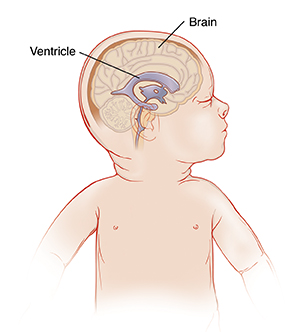Treatment for Hydrocephalus in the Newborn
Cerebrospinal fluid (CSF) is a fluid that circulates through the brain and spinal cord. Ventricles (chambers) inside the brain make the fluid. Normally, the fluid drains out of the brain through the ventricles and into the spinal column. The body then absorbs the fluid. If CSF backs up into the brain, the problem is called hydrocephalus. The buildup causes the ventricles to swell and puts pressure on other parts of the brain. The brain may swell as fluid and pressure build. The pressure can damage brain tissue. In some cases, a healthcare provider drains the fluid and protects the brain from pressure and damage. Common treatments are described in this sheet. The baby stays in the neonatal intensive care unit (NICU) during treatment.
 |
| Normally, fluid circulates through the brain and drains out through the ventricle. |
 |
| With hydrocephalus, fluid backs up into the ventricle. |
Causes of hydrocephalus
Here are the most common causes of treatable hydrocephalus:
-
A blockage in the head prevents CSF from draining
-
The body has problems absorbing CSF
-
The body makes too much CSF
Treating hydrocephalus with medicine
Your child's healthcare provider may prescribe medicine to slow down the flow of CSF temporarily, until the blockage is gone. If this works, your baby may not need other treatment. If your baby needs further treatment, their provider may do 1 of the procedures described below.
Procedures to draw out fluid
The following are possible procedures:
-
Spinal tap. This may be done if the opening between your baby's ventricle and spinal cord is partially blocked. The blockage is often due to an intraventricular hemorrhage. The provider may also do a spinal tap if your baby’s body is making too much CSF. Your provider inserts a small needle into your baby's back, into the fluid-filled space surrounding the spinal cord. Some CSF is drawn out with this needle. This may relieve some of the pressure on the ventricle, allowing the rest of the fluid to drain.
-
Ventricular tap. This may be done if the opening between the ventricle and spinal cord is completely blocked. The healthcare provider places a device similar to a rubber stopper into your baby's skull. This allows access to the ventricle. A provider can then draw fluid out of the ventricle with a needle. This may be done as a temporary solution while waiting for the blockage to go away.
-
Ventricular peritoneal (VP) shunt. This is a tube that your provider places inside your baby's brain. The tube is connected to a thin, flexible tube (catheter) that's tunneled through the body to the stomach. The shunt draws fluid off the brain. The fluid then travels through the catheter and drains into the stomach, where it's soaked up by the body. The shunt and catheter are enclosed under the skin. They can’t be seen from the outside. They’re permanent, but will need to be replaced as the baby grows.
What are the long-term effects?
Hydrocephalus can affect brain development. Damage may range from mild to severe, depending on prompt diagnosis, the underlying cause, and treatment success. Talk to your child's healthcare provider about how your baby is likely to progress. Many children diagnosed with the disorder benefit from rehabilitation therapy and educational intervention and go on to lead normal lives with few limitations. Treatment by an interdisciplinary team of medical professionals, rehabilitation specialists, and educational experts is vital for a positive outcome. Left untreated, progressive hydrocephalus may be fatal.
Online Medical Reviewer:
Liora C Adler MD
Online Medical Reviewer:
Raymond Kent Turley BSN MSN RN
Online Medical Reviewer:
Rita Sather RN
Date Last Reviewed:
10/1/2021
© 2000-2024 The StayWell Company, LLC. All rights reserved. This information is not intended as a substitute for professional medical care. Always follow your healthcare professional's instructions.